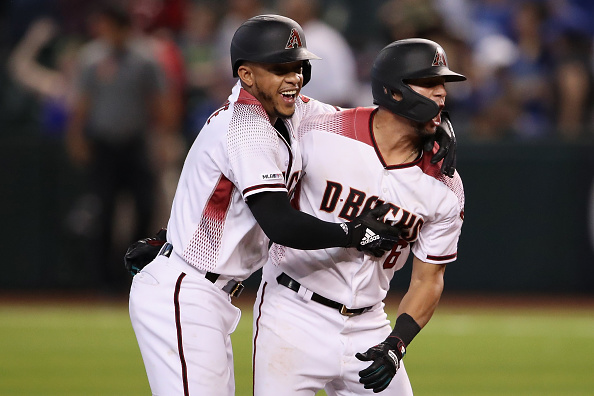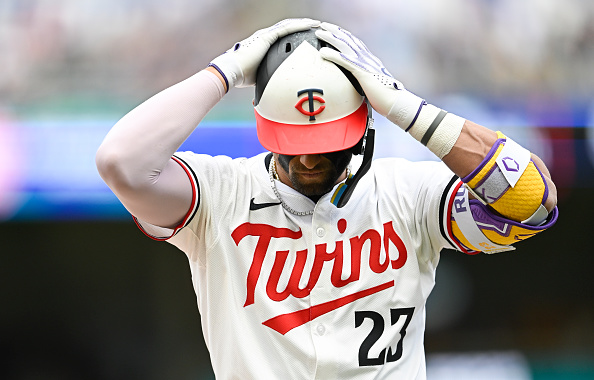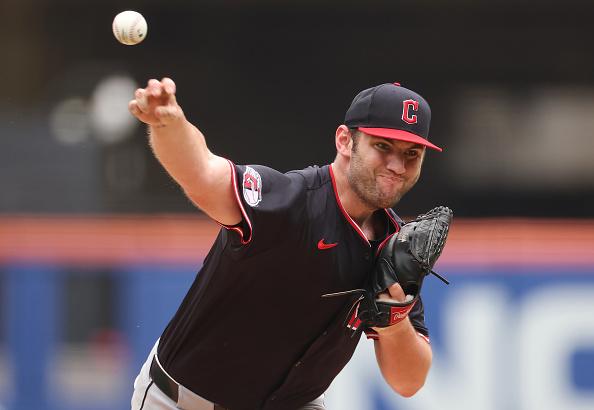The short history of the Arizona Diamondbacks has not yet reached 25 years, but that doesn’t mean that the organization has not had its successes.
Of course, the 2001 champions will be all over this all-time squad. Outside of that dominant team, this is not a franchise loaded with history. Arguably, that makes this a whole lot more fun. Some players who wouldn’t make the Yankees’ A, B, C, or even Z team have a shot to nab a spot. Don’t worry, D-Backs fans, because the all-time team is going to get a lot better in the years to come.
Make sure to check out all of our other All-Time Rosters.
Starting Nine
Miguel Montero, Catcher
Montero was by no means a slouch, but not many people would guess how high up he is in fWAR for Arizona position players. Looking back on it, Montero had some stellar seasons by fWAR thanks to some great defensive play. His best seasons were 2011 and 2012 when he posted 5.9 and 5.6 fWAR, respectively. He showed his offensive talent in 2012 when he had a .391 OBP and 125 wRC+. In total, Montero played in 906 games with 23.3 fWAR, both ranking third in franchise history for batters.
Paul Goldschmidt, First Baseman
Goldschmidt’s departure from the franchise after eight seasons following 2018 was a major sign that times were changing for the Diamondbacks. In Arizona, he carved out a magnificent career that, if he keeps going, could get him into consideration for the Hall of Fame. He finished as the NL MVP runner-up twice: once in 2013 and again two years later. His 2015 campaign was remarkable as he hit 33 home runs with a 1.005 OPS.
As a first baseman, Goldschmidt was a prolific base-stealer for a stretch. In his first six full seasons, he swiped 113 bags, including 32 in 2016. He was and still is a great defender, winning three Gold Gloves to go with his four Silver Sluggers for the franchise. His total OPS with the team is an impressive .930.
Ketel Marte, Second Baseman
The pool for the remaining infielders is noticeably thin. So, we’ll have to settle for the team’s current star. Marte has played a lot of both second base and center field in his career. In five seasons, he has a 122 OPS+, which is heavily raised by his 2019 and 2021 seasons. He finished fourth in NL MVP voting in the former, hitting 32 home runs with a .981 OPS.
This past season, Marte played in just 90 games. He still had a .909 OPS and an OPS+ of 143. As the team is not in a good spot in the present day, Marte could be sold off for a fortune. Even if he is, then his top-two seasons in the desert are still enough to earn him a spot here.
Craig Counsell, Shortstop
The defensive side of baseball had to be highlighted with this spot as Counsell and present-day shortstop Nick Ahmed were fighting for a role. Counsell had two stints with the team, sandwiched around a year playing for Milwaukee, the team he now manages. By no means was Counsell a good hitter; he had an OPS+ of 80 over six seasons. However, Counsell could save runs and swipe bags. He only had a .726 OPS in 2005 but was able to steal 26 bags to accompany his great defense. This rose his seasonal bWAR to 5.5. His overall WAR with the team comes out to 12.7.
Matt Williams, Third Baseman
Williams is mostly known for leading the Giants’ lineup throughout the 1990s before ceding that role to Barry Bonds. But after that, he spent his final six seasons in the desert, winning a championship. Williams was in a decline by 2001, but he was still an MVP finalist as a Diamondback. In 1999, he finished third and hit 35 home runs with a .303 average at age 33. That single season holds up against a weak ending to his career statistically. Still, he also got a ring with the franchise.
Luis Gonzalez, Leftfielder
Yeah, this one isn’t close. Only Goldschmidt has a case to take away the title of the best hitter in franchise history from Gonzalez. What Gonzalez will forever be known for is his walk-off hit to win the World Series. That might not have even been his greatest feat accomplished in 2001. He hit 57 home runs with a .429 OBP and a 1.117 OPS. He was only third in MVP voting that season because Sammy Sosa had a double-digit WAR and Barry Bonds set the home run record.
While his most home runs in a season aside from the 57 was only 31, Gonzalez was still a star player for multiple seasons. He had four seasons with an OPS over .900. All five of his All-Star game appearances came as a Diamondback.
Steve Finley, Centerfielder
Finley came to the Diamondbacks as a 34-year-old veteran who only had one special season under his belt. He left as one of the team’s best players. Finley hit 69 home runs over his first two seasons along with 20 stolen bases and an OPS of .882. He also won a Gold Glove in both seasons.
Finley would add another Gold Glove during his time with the team, reaching over 20 home runs in four seasons in addition to his first two. His total OPS was .851 over six seasons, plus an 18 bWAR.
AJ Pollock, Right Fielder
Before leaving for the Dodgers before 2019, Pollock was a great centerfielder. He will move over to right for defensive reasons. He reached his peak in 2015, making his only all-star team thus far. Pollock hit 20 home runs with 39 stolen bases and a .315 batting average. He missed just about all of the next season but hit 35 bombs with a .800 OPS over the next two.
Justin Upton, Designated Hitter
Another current player, Upton has been away from Arizona for nearly a decade. But as the first overall pick in 2005, he was immediately the future of the team when he debuted at age 19 two years later. It took a couple of seasons, but Upton was able to establish himself as an elite hitter. His breakout season came in 2009 when he hit 26 home runs with 20 stolen bases, a .300 average, and a .899 OPS.
Upton would only spend parts of six seasons with the team before he was traded to Atlanta following his age-24 campaign. Overall, he hit 108 homers while stealing 80 bases and notching an OPS of .832. He did all of this at ages younger than a lot of players enter the league at. His defense does move him to DH for this team.
Starting Rotation
Randy Johnson, LHP
The original signing of Johnson by the Diamondbacks does not get any more legendary. At the age of 35, after dominating with Seattle, he accepted a four-year deal. Johnson proceeded to win the NL Cy Young in all four seasons. Combined, he had a 2.48 ERA, a 2.53 FIP, and 1417 strikeouts in 1030 innings over that period. His ERA+ over that amount of time was 187! For reference, this year’s NL Cy Young winner, Corbin Burnes, had a league-leading 176 ERA+.
Those four years were not Johnson’s only ones in the desert. He stuck around for two more seasons after, striking out 290 and finishing second in Cy Young voting in 2004. He was then traded to the Yankees. After two years in New York, Johnson returned. At that point, he was 43. Johnson was still effective but by no means an ace.
Curt Schilling, RHP
Johnson’s partner in crime on the 2001 team, Schilling was traded for Finley years before either went west to become teammates. Schilling was acquired from Philadelphia in 2000 for four players. They were all solid, but even the best one, Vicente Padilla, came nowhere near Schilling. While he never won the Cy Young award, he finished second on three separate occasions. Over 71 games in 2001 and 2002, he had a 3.10 ERA with 609 strikeouts.
The Schilling era in Arizona ended after only four seasons, as the veteran was traded to Boston for four players who did not match what Schilling did for the Red Sox, which was helping them end their World Series drought. Schilling is of course a controversial figure nowadays, but he is undoubtedly a Hall of Fame-caliber player.
Brandon Webb, RHP
Webb could have been a Hall of Famer if he stayed healthy. In only six seasons, he had a bWAR over 31. He had a 2.84 ERA as a rookie in 2003. For the next five seasons, he was a steady rock, starting between 33 and 35 games a season with his highest ERA being 3.59. In 2006, he won the Cy Young award thanks to a 3.10 ERA and 152 ERA+.
During his first start of 2009, at the age of 30, Webb’s career was cut short. A mysterious shoulder injury destroyed everything. Webb would never pitch again. Still, he is third in franchise history in WAR. He officially retired in 2013 with a 3.27 ERA in just under 200 starts. Despite his low WAR, Webb might still have a Hall of Fame case based on peak alone. Instead, he goes down as one of the most underrated players of the 21st century so far.
Zack Greinke, RHP
When Greinke got north of $200 million from Arizona following a season with a 1.66 ERA for the Dodgers, the expectation was for him to be on one of these lists. And… he is. The Greinke era did get off to a rocky start as he posted a 4.37 ERA in 2016. Luckily, the future Hall of Famer rebounded with a 3.20 and 3.21 ERA in the next two seasons. In 2017, his 9.6 K/9 was his best mark since 2011.
Greinke’s 2019 season was a good one, too. Over 23 starts, he had a 2.90 ERA. But sensing a chance to get out of his contract and recoup some futures, the Diamondbacks sent him to Houston for a four-player package. All four players have made the big leagues, but so far only Josh Rojas has made a substantial impact.
Dan Haren, RHP
After an amazing 2007 season with the A’s, the Diamondbacks sent a package including Carlos Gonzalez, Chris Carter, and Brett Anderson to Oakland for Haren, who delivered in his first two seasons. In 2008, he posted a 3.33 ERA with 206 strikeouts. He would finish fifth in Cy Young voting the next season with a 3.14 ERA and 223 strikeouts, plus a league-best 1.003 WHIP.
Haren’s 2010 season would be his final with Arizona after he got off to an awful start. Haren allowed 10.3 hits per nine innings with a 4.60 ERA in 21 starts. He would be shipped to Los Angeles, where he got hot for the Angels.
Bullpen
Byung-Hyun Kim, RHP
The closer for the 2001 team deserves the ability to close for this team. Kim was not good in the World Series that year, allowing five runs in 3.1 innings. He struck out 113 in 98 innings with 19 saves and a 2.94 ERA that year, but the 2002 season was Kim’s best. As a 23-year-old, he had a 2.04 ERA with 92 strikeouts.
That was the end of Kim’s closing career in Arizona. He moved to the rotation for 2003 but was traded after seven starts for infielder Shea Hillenbrand. Kim returned in 2007 after the team claimed him off waivers. The second stint lasted two starts before he was released.
Patrick Corbin, LHP
Corbin is the one starter to move to the bullpen due to a virtual tie with Haren. Speaking of which, Corbin came to Arizona from Los Angeles for Haren. He made his first All-Star team in 2013 in his second season, finishing with a 3.41 ERA and 178 strikeouts. Tommy John surgery seemed to derail his career for a little while; he didn’t post good numbers again until 2018.
Corbin was dominant that season, striking out 246 batters in 200 innings with a 3.15 ERA. Led by his 2.47 FIP, he finished fifth in Cy Young voting. He left for Washington, D.C., where he won the World Series in his first year.
Jose Valverde, RHP
In his five seasons for the Diamondbacks, Valverde was a strikeout machine (331 in 260 innings). His total ERA was 3.29, which is inflated by his 5.84 in 2006. Valverde’s 2007 was by far his top season as he received two Cy Young votes. Valverde had a 2.66 ERA with 78 strikeouts in 64.1 innings to go along with a league-leading 47 saves. He was then traded to Houston for three players. Valverde would go on to lead the league in saves two more times.
Archie Bradley, RHP
The seventh overall pick in 2011, Bradley broke out after transitioning to the bullpen in 2017. He posted a 1.73 ERA with 79 strikeouts in 73 innings. Bradley didn’t get a Cy Young vote that season but did receive one for MVP. He took over the closer role in 2019 but was traded to the Reds a year later. Now on the Phillies, Bradley had a 9.3 K/9 during his time with Arizona, plus over 10.0 after moving to a relief role.
J.J. Putz, RHP
An elite closer for multiple seasons in Seattle, Putz came to the desert via free agency before 2011. In his first three seasons with the club, he had a 2.45 ERA with 164 strikeouts and 83 saves in 146.2 innings. Putz struggled in 2014 and never played again. At that point, he was 37. Only Valverde has more saves in team history.
Brad Ziegler, RHP
The side-armed Ziegler was acquired from Oakland in 2011 for two players who combined for a negative career WAR. He was an elite reliever for the team until a trade to Boston in 2016. He had a 1.85 ERA in 2015, two years after he made a league-high 78 appearances.
Arizona did not get any major leaguers from the Red Sox in return. Ziegler would end up retiring a Diamondback, as the Marlins shipped up back to the desert in 2018. In his seven total seasons with the team, Ziegler posted a 2.57 ERA in 357.1 innings.
Andrew Chafin, LHP
The only southpaw in the ‘pen, Chafin was a consistent left-handed specialist for his seven seasons with the team. Despite appearing in 337 games for Arizona, Chafin only completed 271.2 innings. His total ERA was 3.68 with 288 strikeouts.
Bench
David Peralta, Outfielder
Along with Marte, Peralta is one of two current Diamondbacks on this team. He has a steady bat and an ability to get on base. From 2017 to 2019, he hit .288 with a .349 OBP and an OPS of .825. In 2018, he hit a career-high 30 bombs. One skill of his is hitting triples. He hit nine in 88 games in his rookie season of 2014. Peralta also led the league in triples in 2015 and recently in 2021.
Chris Young, Outfielder
Young came to Arizona as a prospect when the team traded Javier Vazquez to Chicago. He established himself as an above-average defense outfielder with a solid bat. Young hit 132 home runs with 112 stolen bases over seven seasons. His 14.4 fWAR ranks eighth among Diamondback position players.
Aaron Hill, Second Baseman
The Diamondbacks gave away Kelly Johnson to Toronto in 2011 for Hill, who made a great first impression on the team by posting a .878 OPS in 33 games. Hill came back the next season and hit 26 home runs with 14 stolen bases. He won his second Silver Slugger award that year and also received a vote for MVP. After another good campaign in 2013, Hill derailed for his final two seasons as a Diamondback. In 2016, he was dealt to the Brewers as part of the package for Jean Segura.
Jay Bell, Infielder
Bell was a very good player for the Pirates over eight seasons before he signed as a free agent with the Diamondbacks. His second season with the team was 1999, where he made it all worth it. Bell hit 38 home runs with a .931 OPS, finishing 13th in MVP voting along with an All-Star nomination. That was the height of Bell’s performance with the Diamondbacks. Still, he won a ring as a 35-year-old in 2001.
Mark Reynolds, Corner Infielder
Let’s get some power for the final bench spot. A 16th-rounder in 2004, Reynolds was a player who would have succeeded more in modern-day baseball. He led the league in strikeouts in 2008, 2009, and 2010. This could be why he was traded to Baltimore after 2010. But what Reynolds lacked in contact rate, he made up for in pure power. He hit 44 home runs with a .892 OPS in 2009. He also stole 24 bases that season. Reynolds hit a combined 50 home runs in 2008 and 2010. He was a pure slugger.
Check us out on our socials:
Twitter: @PTSTNews and @TalkPrimeTime
Facebook Page: Prime Time Sports Talk
Join our Facebook Group: Prime Time Sports Talk
Instagram: @primetimesportstalk
Follow Carter LaCorte on Twitter @CarterHudBlog
Main Image Credit:







